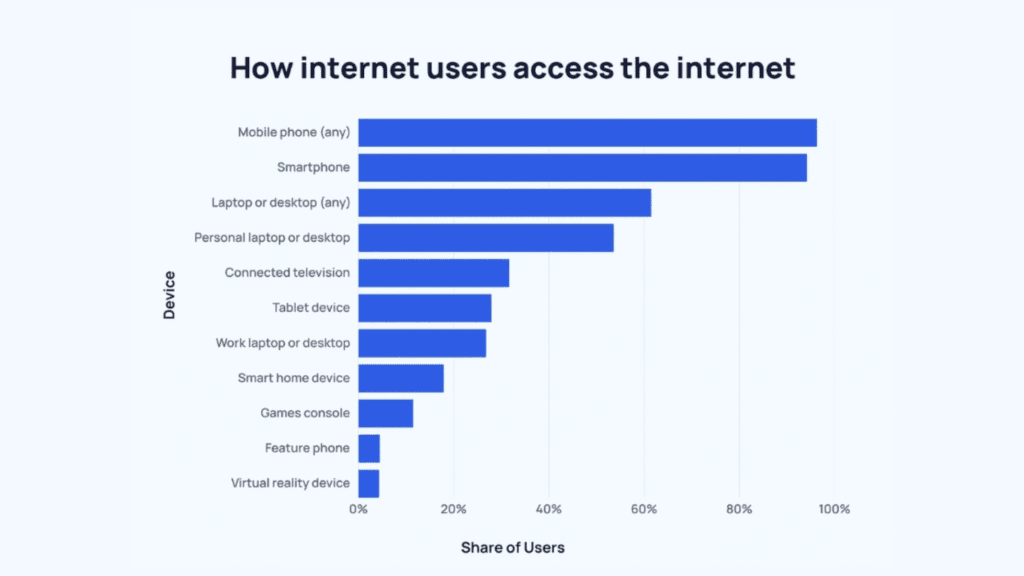In this digital world, people are glued to their phones more than ever. Whether it’s searching for a nearby cafe, booking a haircut, or reading the news, mobile devices have become our primary gateway to the internet. And this is exactly why Mobile SEO matters more than ever.
In this blog, we’ll explore,
- Why is Mobile SEO important?
- The Advantages of Mobile SEO
- How DigiFix, Melbourne’s #1 SEO agency can help you master your mobile SEO game.

What is Mobile SEO?
Mobile SEO (Mobile Search Engine Optimisation) is the process of optimizing your website to provide an excellent user experience on mobile devices—smartphones and tablets. It involves multiple technical and design elements that improve usability, accessibility, and performance for mobile users. Here’s what mobile SEO includes:
- Fast loading speeds: Websites that load in under 3 seconds perform significantly better on mobile.
- Readable content: Text should be easy to read without zooming or horizontal scrolling.
- Easy navigation: Menus and buttons should be large and touch-friendly.
- Responsive design: The site layout should automatically adjust to different screen sizes.
- Minimal intrusive pop-ups: These can negatively impact user experience and SEO rankings.
For example, imagine someone searching for a plumber while their kitchen pipe bursts. They’ll likely use their phone to find help quickly. If your site is slow or poorly laid out on mobile, they’ll move on to a competitor—fast.
Why is Mobile SEO Important?
In today’s fast-paced, smartphone-driven world, having a mobile-optimized website isn’t just an option — it’s a necessity. Mobile SEO ensures your site delivers a smooth, fast, and user-friendly experience on smartphones and tablets.

Source: Exploding Topics
Considering that over 60% of global internet traffic now comes from mobile devices, failing to optimize for mobile means missing out on the majority of your potential visitors.
Let’s explore “Why is Mobile SEO important?” and what it means for your business.
- Mobile-First Indexing is the Norm
In 2019, Google officially switched to mobile-first indexing. That means that the mobile version of your website is what Google primarily uses to determine rankings — not your desktop version. Even if a search is made from a laptop or desktop, Google evaluates your mobile site’s performance, content, and usability first.
Why this matters:
- If your mobile site is slow, incomplete, or poorly structured, it could negatively affect your overall rankings.
- Important content that appears only on the desktop version and is hidden or missing on mobile will likely be ignored by Google.
- Structured data, meta tags, and internal linking should be present and optimized on both mobile and desktop — but mobile is now the priority.
👉 Bottom line: If your mobile experience is poor, your search rankings can suffer, even if your desktop site is perfect.
- Dominance of Mobile Traffic
More than 60% of global web traffic now comes from mobile devices. This means that the majority of your website visitors are likely to be on their phones.
Google has reported 27.8 billion more queries performed on mobile than on desktops. This explosive growth in mobile usage means your website should be designed and optimized for phones first — not as an afterthought.
Websites that aren’t responsive or mobile-friendly force users to pinch, zoom, or scroll awkwardly, leading to frustration and high bounce rates. If your website isn’t optimized for smartphones, you’re likely turning away more than half your visitors.
- Enhanced User Experience (UX)
Great mobile SEO goes hand-in-hand with great user experience. A mobile-optimized website loads quickly, looks good on small screens and is easy to use with a thumb. This isn’t just about aesthetics — it directly impacts your bottom line.
For instance, 69% of mobile users say they are more likely to buy from a site that answers their questions easily. Fast load times, clear content structure, and intuitive navigation all contribute to a better experience. A positive UX leads to:
- Lower bounce rates because users aren’t frustrated by a clunky layout.
- Higher engagement, with users spending more time exploring your pages.
- More conversions, whether that means purchases, form submissions, or phone calls.
On the flip side, users who have a negative mobile experience are 62% less likely to purchase from that site in the future — showing just how high the stakes are.
- Impact on Local SEO
Many mobile searches are driven by immediate, local intent — like “coffee shop near me” or “emergency plumber in [city].” In fact, 46% of all Google searches have local intent, and 30% of mobile searches include a location-based keyword.
This behavior underscores the importance of mobile SEO for brick-and-mortar businesses and service providers. A well-optimized mobile site, paired with a complete and active Google Business Profile, increases your chances of appearing in local map results and “near me” searches — right when users are ready to act.
- Competitive Advantage
Not every business takes mobile SEO seriously — and that gives you a valuable edge. Sites that are mobile-friendly not only rank better but also provide the kind of modern, convenient experience users expect.
A mobile-optimized e-commerce site, for example, is more likely to convert visitors. And it’s not just about planned purchases: mobile users are 40% more likely to make impulse buys compared to desktop users. Businesses that fail to create smooth, responsive mobile experiences are simply leaving money — and market share — on the table.
- Google’s Ranking Factors: Speed, Usability, and Core Web Vitals
Google’s algorithms reward websites that perform well on mobile — particularly when it comes to speed and stability. Three key metrics known as Core Web Vitals are now part of Google’s ranking system:
- Largest Contentful Paint (LCP): How fast the main content loads
- First Input Delay (FID): How quickly the site responds to user actions
- Cumulative Layout Shift (CLS): How stable the page layout is during loading
These metrics are especially critical on mobile, where users expect fast, glitch-free experiences even on slower networks. Sites that meet Google’s standards are more likely to rank higher, receive more traffic, and retain users longer.
Mobile SEO Isn’t Optional — It’s Business-Critical
Let’s recap with a few more compelling insights:
- 61% of users say they have a better opinion of businesses with mobile-friendly websites.
- 56% of online sales in 2024 were completed via smartphones, and this number is projected to grow to 88% by 2027.
- 82% of mobile users search on their phones while in physical stores — blending offline and online retail.
These figures aren’t just numbers — they reflect real behavior and expectations. If your site isn’t ready for mobile users, you’re not just risking poor SEO — you’re losing trust, conversions, and revenue.
Final Thoughts: Embrace Mobile SEO for Growth
The way people use the internet has changed, and businesses that adapt will thrive. Mobile SEO is no longer a side project or a technical upgrade — it’s a core part of digital success.
From increasing visibility and engagement to capturing more local and mobile-driven traffic, the benefits are clear. Whether you’re an e-commerce brand, a local business, or a service provider, optimizing for mobile users is essential to stay competitive in 2025 and beyond. We hope this blog answers your question “Why is Mobile SEO Important?”
Boost Your Rankings & Conversions with Mobile SEO Services from DigiFix!
In this mobile-first world, your website should perform flawlessly on smartphones — or risk being ignored by both users and search engines. That is where DigiFix comes in.
We help businesses unlock the full potential of mobile traffic with powerful, results-driven Mobile SEO strategies tailored for growth. Whether you are struggling with slow load times, poor mobile usability, or low conversions from mobile users — we are here to fix it.
DigiFix’s Mobile SEO Services Include:
- Comprehensive Mobile SEO Audit
We dig deep into your mobile site performance, analyzing structure, usability, speed, and content to identify what is holding you back.
- Mobile Page Speed & Core Web Vitals Optimization
We optimize your website for fast loading, responsive design, and Google Core Web Vitals, helping you climb the rankings and retain visitors.
- Mobile-Friendly Content Creation
Our SEO content is designed for small screens — readable, engaging, and structured to keep users scrolling and clicking.
- Local SEO for Mobile Users
We assure your business appears in mobile “near me” searches by enhancing your local SEO and Google Business Profile presence.
- Technical Fixes for Mobile Usability
From clickable elements to viewport settings, we can fix mobile-specific issues that cause poor user experience and SEO penalties.
Why do Businesses Trust DigiFix for Mobile SEO?
- Expertise with Google’s Mobile-First Indexing Guidelines
- The data-driven approach focused on real ROI
- Proven results across eCommerce, service businesses, and local brands
- Transparent communication and ongoing support
Ready to Capture More Mobile Traffic?
Don’t let mobile visitors slip away. Let DigiFix optimize your website for speed, usability, and mobile search performance — and turn smartphones into sales engines.
Frequently Asked Questions (FAQs) About Mobile SEO
- What is Mobile SEO?
Mobile SEO is the process of optimizing your website for users accessing it through mobile devices, like smartphones and tablets. It ensures that your site loads quickly, displays correctly on small screens, and provides a smooth user experience — all while complying with Google mobile-first indexing standards.
- Why is Mobile SEO more important now than ever before?
Because the majority of online traffic now comes from mobile devices. Over 60% of all internet users browse the web on smartphones, and Google uses the mobile version of your site for ranking and indexing. If you haven’t optimized your site for mobile, you risk losing visibility, traffic, and potential customers.
- How does Mobile SEO affect my Google rankings?
Mobile SEO plays a direct role in how Google ranks your site. Google considers mobile-friendliness, page speed, and Core Web Vitals as key ranking signals. A poorly optimized mobile site can hurt your position in search engine results — even if your desktop version is perfectly fine.
- What’s the difference between desktop SEO and mobile SEO?
Desktop SEO focuses on performance and experience for larger screens, while Mobile SEO optimizes content layout, speed, and usability specifically for smaller screens and mobile behaviors. With mobile-first indexing, mobile optimization takes priority in search engine ranking decisions.
- What are Core Web Vitals, and why do they matter for mobile?
Core Web Vitals are a set of performance metrics that measure how quickly your site loads, how stable it is during loading, and how responsive it is to user interactions — all especially important on mobile devices. These vitals are official ranking factors used by Google, and failing to meet their benchmarks can lower your rankings.
- How does Mobile SEO impact local businesses?
Mobile users often perform location-based searches like “restaurants near me” or “emergency plumber in [city].” Mobile SEO — combined with a well-optimized Google Business Profile — can dramatically boost your visibility in local search results and help drive foot traffic or calls to your business.
- Can Mobile SEO help increase conversions?
Yes. A fast, user-friendly mobile experience makes it easier for visitors to browse your site, find what they need, and take action — whether it’s making a purchase, filling out a form, or calling your business. 69% of mobile users say they’re more likely to buy from a mobile-friendly site.
- How can DigiFix help with Mobile SEO?
DigiFix offers expert Mobile SEO services including:
- Comprehensive mobile audits
- Core Web Vitals optimization
- Mobile-friendly content creation
- Local SEO for mobile search
- Fixing mobile usability issues
We help businesses boost rankings, improve user experience, and convert more mobile traffic into customers.
- How do I know if my website is mobile-friendly?
You can use Google’s Mobile-Friendly Test or the Mobile Usability Report in Google Search Console to identify issues. Or better yet, let DigiFix conduct a free Mobile SEO audit to give you a full breakdown of what’s working — and what needs fixing.
- Is Mobile SEO a one-time fix?
No — it requires ongoing monitoring and updates. Mobile algorithms evolve, user behavior changes and performance can fluctuate. DigiFix provides continuous support to keep your mobile SEO strategy up-to-date and effective long-term.





0 Comments